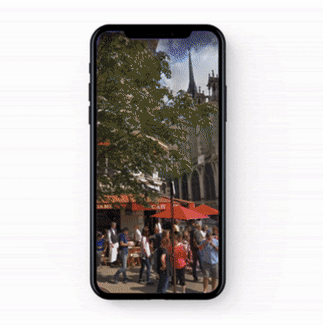
Stitching Together the Truth
Using blockchain to fight misinformation by constructing holistic view of any event through validated imagery

Misinformation
In this age of information overload, we tend to make snap judgements based on fragmented information instead of conducting thorough research. However, this tendency often is the source of misinformation and misperception that has problematic influence on our economic, environmental, and political outcomes.
Fake news is a common type of misinformation, and here’s an example of a fake CNN Twitter account spreading misinformation regarding the Notre Dame fire in Paris.
At a glance without side to side comparison, it is easy to mistake the one on the left as the real CNN account, and you can imagine how fast this false information of terrorist attack can spread across the internet.


So wouldn’t the the world be a better place if there’s a way for us to see the holistic view of any event so we can verify the truth ourselves?
Existing Technology
There are some companies currently use technologies to tackle this issue. For example, Facebook can take hundreds of photos and piece them together to recreate a scene in 3D.

Video credit: https://techcrunch.com/2018/06/07/how-facebooks-new-3d-photos-work/
A blockchain based company, Truepic, verifies the trustworthiness of individual images. They use their algorithm to inspect the data embedded in an image such as timestamp, geolocation, and devices used to take that photo, and verifies its authenticity to fight issues such as content manipulation, location spoofing, and AI-generated images.

Image credit: https://truepic.com/
So what if there’s a way that we can validate the authenticity of each photo, stitch them together to recreate the scene of an event, and make sure no one can tamper with its information?
Proposal Concept
Here’s what we envisioned: combining 3D model building technology, such as the one Facebook demonstrated, with Truepic’s process of verifying photo authenticity.
How does this work? Imagine you are putting together a 3D puzzle, each image or video of a particular event is a puzzle piece.

Since people are taking photos and videos all the time, we are almost certain that we can have enough pieces to put together the 3D puzzle.
So here’s how it works: when people walk pass an event, they use their phones to take photos. They then come to this platform we plan to build and upload those photos. At first there will only be seemingly unrelated photos, and once each photo is verified to be true, they’ll be placed on Google Street View to show what happened at that location. As more users upload their photos, images start to overlap, and we start to get more angles, this potential platform can then generate a 3D model from the all these photos.

Prototype

When users go on to the platform to look at an event, they’ll find verified photos and videos on top of Google Street View as they move around the scene from different angles.
Blockchain Application

Economic Model
The whole platform itself is funded by from news outlet, government, people’s micro donations. Since there is no middle man, all the funds goes directly to people who had contributed.
If only one person uploads an image about an event, nothing really happens; however, if more and more people start to upload images, we’ll start to see the scene as photos overlap.

Based on the finished constructed scene- the amount funding the event will be distributed to users based on the percentage their photos overlap with the scene. For example, if your photo overlaps or contributes to construct 10% of a scene, you will receive 10% of the total amount. Furthermore, since this is on a blockchain network, all the transaction are transparent as a public ledger for anyone to view.

Feedback & Thank You

After our presentation at UNICEF headquarter in New York, our team was approached by Bounties network’s (a freelance network built on Ethereum) founder, Simona Pop. She was interested in our idea and suggested that a way to ensure all angles of a scene can be captured is to issue bounties on her network to have people take photos or videos of missing areas.
I wanted to thank my teammates Man-Ping, Tina, and Yan for working tirelessly together to bring this idea to fruition. I also wanted to thank our instructors Benny (from NYU IDM), Chris, Christina, and Mehran (from UNICEF) for facilitating our ideation process and teaching us about blockchain.